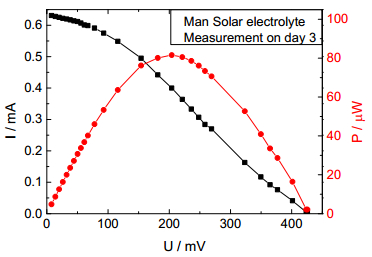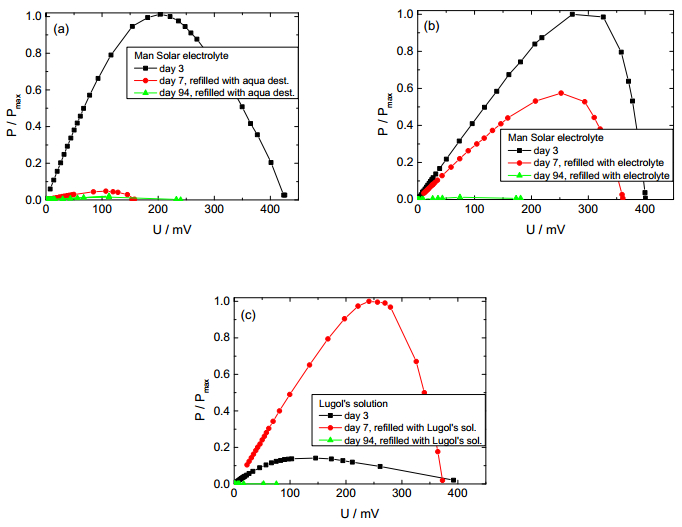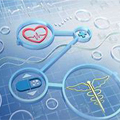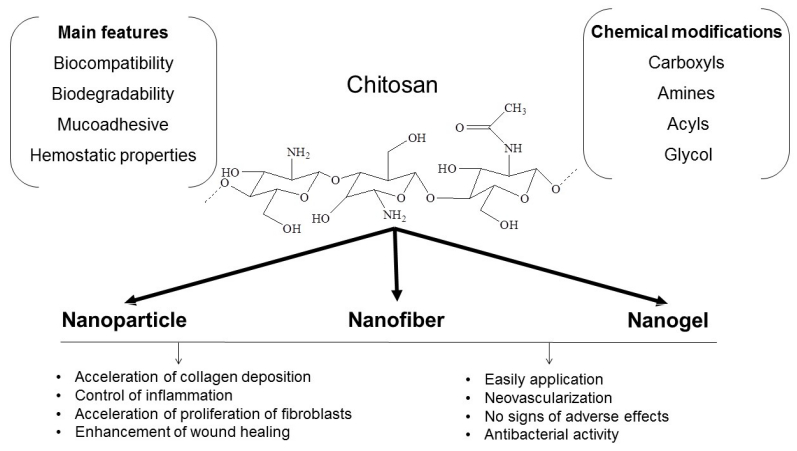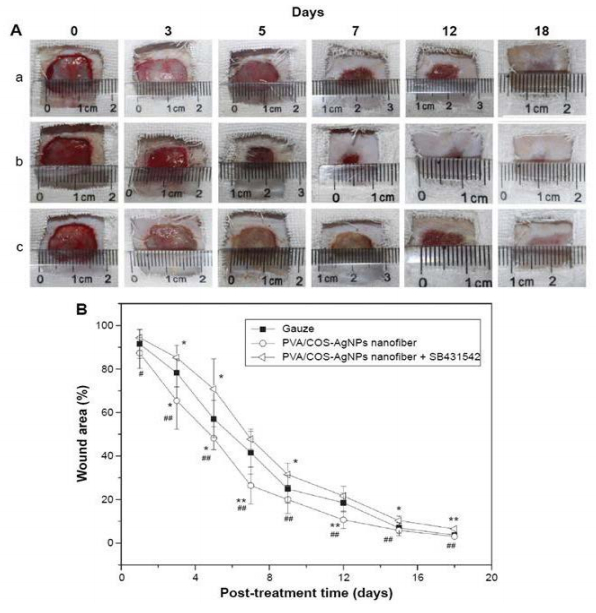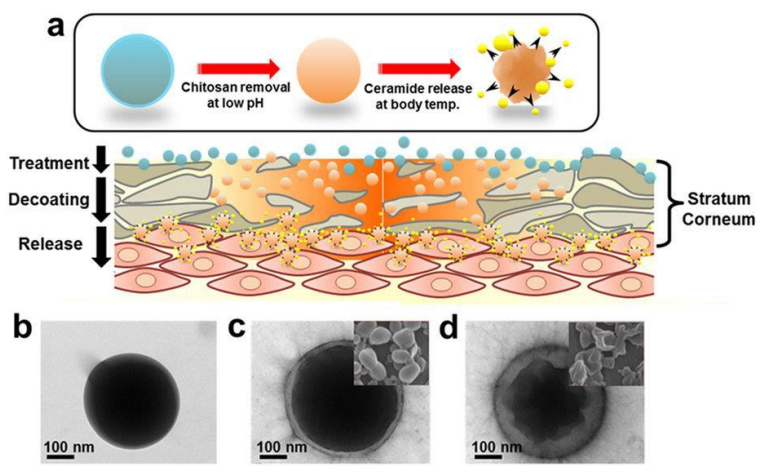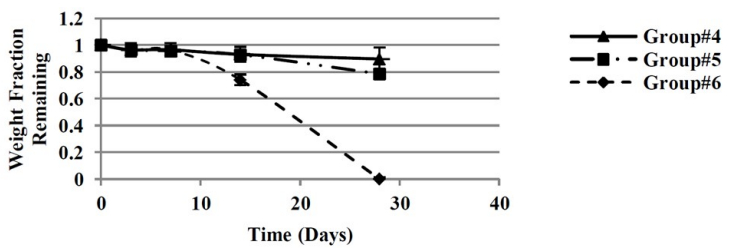|
[1]
|
Gantwerker EA, Hom DB (2011) Skin: histology and physiology of wound healing. Facial Plast Surg Clin N Am 19: 441-453.
|
|
[2]
|
Sorg H, Tilkorn DJ, Hager S, et al. (2017) Skin wound healing: An update on the current knowledge and concepts. Eur Surg Res 58: 81-94.
|
|
[3]
|
Gonzalez ACD, Costa TF, Andrade ZD, et al. (2016) Wound healing-A literature review. An Bras Dermatol 91: 614-620.
|
|
[4]
|
Ahmed S, Ikram S (2016) Chitosan based scaffolds and their applications in wound healing. Achievements Life Sci 10: 27-37.
|
|
[5]
|
Azuma K, Izumi R, Osaki T, et al. (2015) Chitin, chitosan, and its derivatives for wound healing: Old and new materials. J Funct Biomater 6: 104-142.
|
|
[6]
|
Cortivo R, Vindigni V, Iacobellis L, et al. (2010) Nanoscale particle therapy for wounds and ulcers. Nanomedicine 5: 641-656.
|
|
[7]
|
Andrews JP, Marttala J, Macarak E, et al. (2016) Keloids: The paradigm of skin fibrosis – Pathomechanisms and treatment. Matrix Biol 51: 37-46.
|
|
[8]
|
Mari W, Alsabri SG, Tabal N, et al. (2015) Novel insights on understanding of keloid scar: Article review. J Am Coll Clin Wound Spec 7: 1-7.
|
|
[9]
|
Mordorski B, Prow T (2016) Nanomaterials for wound healing. Curr Dermatol Rep 5: 278-286.
|
|
[10]
|
Ahmadi F, Oveisi Z, Samani M, et al. (2015) Chitosan based hydrogels: characteristics and pharmaceutical applications. Res Pharm Sci 10: 1-16.
|
|
[11]
|
Elgadir MA, Uddin MS, Ferdosh S, et al. (2015) Impact of chitosan composites and chitosan nanoparticle composites on various drug delivery systems: A review. J Food Drug Anal 23: 619-629.
|
|
[12]
|
Patel S, Goyal A (2017) Chitin and chitinase: Role in pathogenicity, allergenicity and health. Int J Biol Macromolec 97: 331-338.
|
|
[13]
|
Baldrick P (2010) The safety of chitosan as a pharmaceutical excipient. Regul Toxicol Pharmacol 56: 290-299.
|
|
[14]
|
Dutta PK (2016) Chitin and chitosan for regenerative medicine. Springer India: 2511-2519.
|
|
[15]
|
Chaudhari AA, Vig K, Baganizi DR (2016) Future prospects for scaffolding methods and biomaterials in skin tissue engineering: A review. Int J Mol Sci 17: 1974.
|
|
[16]
|
Parani M, Lokhande G, Singh A, et al. (2016) Engineered nanomaterials for infection control and healing acute and chronic wounds. ACS Appl Mater Interfaces 8: 10049-10069.
|
|
[17]
|
Siravam AJ, Rajitha P, Maya S, et al. (2015) Nanogels for delivery, imaging and therapy. WIREs Nanomed Nanobiotechnol 7: 509-533.
|
|
[18]
|
Kean T, Thanou M (2010) Biodegradation biodistribution and toxicity of chitosan. Adv Drug Deliv Rev 62: 3-11.
|
|
[19]
|
Moura MJ, Brochado J, Gil MH, et al. (2017) In situ forming chitosan hydrogels: Preliminary evaluation of the in vivo inflammatory response. Mater Sci Eng C 75: 279-285.
|
|
[20]
|
Zhao Y, Qiu Y, Wang H, et al. (2016) Preparation of nanofibers with renewable polymers and their application in wound dressing. Int J Polym Sci. Article ID 4672839. doi: http://dx.doi.org/10.1155/2016/4672839.
|
|
[21]
|
Jayakumar R, Menon D, Manzoor K, et al. (2010) Biomedical applications of chitin and chitosan based nanomaterials-A short review. Carbohydr Polym 82: 227-232.
|
|
[22]
|
 Salehi M, Farzamfar S, Bastam F, et al. (2016) Fabrication and characterization of electrospun PLLA/collagen nanofibrous scaffold coated with chitosan to sustain release of aloe vera gel for skin tissue engineering. Biomed Eng Appl Basis Commun 28: 1650035. Salehi M, Farzamfar S, Bastam F, et al. (2016) Fabrication and characterization of electrospun PLLA/collagen nanofibrous scaffold coated with chitosan to sustain release of aloe vera gel for skin tissue engineering. Biomed Eng Appl Basis Commun 28: 1650035.
|
|
[23]
|
Yildirimer L, Thanh NTK, Seifalian AM (2012) Skin regeneration scaffolds: a multimodal bottom-up approach. Trends Biotechnol 30: 638-648.
|
|
[24]
|
Chen JP, Chang GY, Chen JK (2008) Electrospun collagen/chitosan nanofibrous membrane as wound dressing. Colloids Surf A 313-314: 183-188.
|
|
[25]
|
Sun K, Li ZH (2011) Preparations, properties and applications of chitosan based nanofibers fabricated by electrospinning. Express Polym Lett 5: 342-361.
|
|
[26]
|
Muzzarelli RAA, Mehtedi ME, Mattioli-Belmonte M (2014) Emerging biomedical applications of nano-chitins and nano-chitosans obtained via advanced eco-Friendly technologies from marine resources. Mar Drugs 12: 5468-5502.
|
|
[27]
|
Oyarzun-Ampuero F, Vidal A, Concha M, et al. (2015) Nanoparticles for the treatment of wounds. Curr Pharm Des 221: 4329-4341.
|
|
[28]
|
Manchanda R, Surendra N (2010) Controlled size chitosan nanoparticles as an efficient. Biocompatible oligonucleotides delivery system. J Appl Polym Sci 118: 2071-2077.
|
|
[29]
|
Brunel F, Véron L, David L, et al. (2008) A novel synthesis of chitosan nanoparticles in reverse emulsion. Langmuir 24: 11370-11377.
|
|
[30]
|
Tokumitsu H, Ichikawa H, Fukumori Y, et al. (1999) Preparation of gadopentetic acid- loaded chitosan microparticles for gadoliniumneutron-capture therapy of cancer by a novel emulsion-droplet coalescence technique. Chem Pharm Bull 47: 838-842.
|
|
[31]
|
Agnihotri S, Aminabhavi TM (2007) Chitosan nanoparticles for prolonged delivery of timolol maleate. Drug Dev Ind Pharm 33: 1254-1262.
|
|
[32]
|
El-Shabouri MH (2002) Positively charged nanoparticles for improving theoral bioavailability of cyclosporin-A. Int J Pharm 249: 101-108.
|
|
[33]
|
Cardozo VF, Lancheros CAC, Narciso AM, et al. (2041) Evaluation of antibacterial activity of nitric oxide-releasing polymeric particles against Staphylococcus aureus from bovine mastitis. Int J Pharm 473: 20-29.
|
|
[34]
|
Pelegrino MT, Silva LC, Watashi CM, et al (2017) Nitric oxide-releasing nanoparticles: synthesis, characterization, and cytotoxicity to tumorigenic cells. J Nanopart Res 19: 57.
|
|
[35]
|
Pelegrino MT, Weller RB, Chen X, et al. (2017) Chitosan nanoparticles for nitric oxide delivery in human skin. Med Chem Comm 4: 713-719.
|
|
[36]
|
Bugnicourt L, Ladavière C (2016) Interests of chitosan nanoparticles ionically cross-linked with tripolyphosphate for biomedical applications. Prog Polym Sci 60: 1-17.
|
|
[37]
|
Soni KS, Desale SS, Bronich TK (2016) Nanogels: An overview of properties, biomedical applications and obstacles to clinical translation. J Control Release 240: 109-126.
|
|
[38]
|
Caló E, Khutoryanskiy V (2015) Biomedical applications of hydrogels: A review of patents and commercial products. Eur Polym J 65: 252-267.
|
|
[39]
|
Huang R, Li W, Lv X, et al. (2015) Biomimetic LBL structured nanofibrous matrices assembled by chitosan/collagen for promoting wound healing. Biomaterials 53: 58-75.
|
|
[40]
|
Li CW, Wang Q, Li J, et al. (2016) Silver nanoparticles/chitosan oligosaccharide/poly(vinyl alcohol) nanofiber promotes wound healing by activating TGFβ1/Smad signaling pathway. Int J Nanomedicine 11: 373-387.
|
|
[41]
|
Liu M, Shen Y, Ao P, et al. (2014) The improvement of hemostatic and wound healing property of chitosan by halloysite nanotubes. RSC Adv 4: 23540-23553.
|
|
[42]
|
Mahdavi M, Mahmoudi N, Anaran FR, et al. (2016) Electrospinning of nanodiamond-modified polysaccharide nanofibers with physico-mechanical properties close to natural skins. Mar Drugs 14: 128. doi: 10.3390/md14070128

|
|
[43]
|
Georgii JL, Amadeu TP, Seabra AB, et al. (2011). Topical S-nitrosoglutathione-releasing hydrogel improves healing of rat ischemic wounds. J Tissue Eng Regen Med 5: 612-619.
|
|
[44]
|
Zhou X, Wang H, Zhang J, et al. (2017) Functional poly(ε-caprolactone)/chitosan dressings with nitric oxide-releasing property improve wound healing. Acta Biomater 54: 128-137.
|
|
[45]
|
Veleirinho B, Coelho DS, Dias PF, et al. (2012) Nanofibrous poly(3-hydroxybutyrate-co-3-hydroxyvalerate)/chitosan scaffolds for skin regeneration. Int J Biol Macromolec 51: 343-350.
|
|
[46]
|
Archana D, Dutta J, Dutta PK (2013) Evaluation of chitosan nano dressing for wound healing: Characterization, in vitro and in vivo studies. Int J Biol Macromolec 57: 193-203.
|
|
[47]
|
Cao H, Chen MM, Liu Y, et al. (2015) Fish collagen-based scaffold containing PLGA microspheres for controlled growth factor delivery in skin tissue engineering. Colloids Surf B Biointerfaces 136: 1098-1106.
|
|
[48]
|
Gharatape A, Milani M, Rasta SH, et al. (2016) A novel strategy for low level laser-induced plasmonic photothermal therapy: the efficient bactericidal effect of biocompatible AuNPs@(PNIPAAM-co-PDMAEMA, PLGA and chitosan). RSC Adv 6: 110499-110510.
|
|
[49]
|
Jung SM, Yoon GH, Lee HC, et al. (2015) Thermodynamic insights and conceptual design of skin sensitive chitosan coated ceramide/PLGA nanodrug for regeneration of Stratum corneum on atopic dermatitis. Sci Rep 5: 18089.
|
|
[50]
|
Seabra AB, Kitice NA, Pelegrino MT, et al. (2015) Nitric oxide-releasing polymeric nanoparticles against Trypanosoma cruzi. J Phys: Conf Series 617: 012020.
|
|
[51]
|
Seabra AB, Duran N (2012) Nanotechnology allied to nitric oxide release materials for dermatological applications. Curr Nanosci 8: 520-525.
|
|
[52]
|
Seabra AB, Duran N (2017) Nanoparticulated nitric oxide donors and their biomedical applications. Mini Rev Med Chem 17: 216-223.
|
|
[53]
|
Han G, Martinez LR, Mihu MR, et al. (2009) Nitric oxide releasing nanoparticles are therapeutic for Staphylococcus aureus abscesses in a murine model of infection. PLoS One 4: e7804.
|
|
[54]
|
Shome S, Das TA, Choudhury MD, et al. (2016) Curcumin as potential therapeutic natural product: a nanobiotechnological perspective. J Pharm Pharmacol 68: 1481-1500.
|
|
[55]
|
Karri VV, Kuppusamy G, Talluri SV, et al. (2016) Curcumin loaded chitosan nanoparticles impregnated into collagen-alginate scaffolds for diabetic wound healing. Int J Biol Macromol 93: 1519-1529.
|
|
[56]
|
SeabraAB, Pankotai E, Feher M, et al. (2007) S-nitrosoglutathione-containing hydrogel increases dermal blood flow in streptozotocin-induced diabetic rats. Br J Dermatol 156: 814-818.
|
|
[57]
|
Lin YH, Lin JH, Hong YS (2017). Development of chitosan/poly-g-glutamic acid/pluronic/curcumin nanoparticles in chitosan dressings for wound regeneration. J Biomed Mater Res Part B 105B: 81-90.
|
|
[58]
|
Lin YH, Lin JH, Li TS, et al. (2016) Dressing with epigallocatechin gallate nanoparticles for wound regeneration. Wound Repair Regen 24: 287-301.
|
|
[59]
|
Nawaz A, Wong TW (2017) Microwave as skin permeation enhancer for transdermal drugdelivery of chitosan-5-fluorouracil nanoparticles. Carbohydr Polym 157: 906-919.
|
|
[60]
|
Piras AM, Maisetta G, SandreschiS, et al. (2015) Chitosan nanoparticles loaded with the antimicrobial peptide temporin B exert a long-term antibacterial activity in vitroagainst clinical isolates of Staphylococcus epidermidis. Front Microbiol 6: 372.
|
|
[61]
|
Ramasamy T, Kim JO, Yong CS, et al. (2015) Novel core–shell nanocapsules for the tunable delivery of bioactive rhEGF: Formulation, characterization and cytocompatibility studies. J Biomater Tissue Eng 5: 730-743.
|
|
[62]
|
Romić MD, Klarić MŠ, Lovrić J, et al. (2016) Melatonin-loaded chitosan/Pluronic® F127 microspheres as in situforming hydrogel: An innovative antimicrobial wound dressing. Eur J Pharm Biopharm 107: 67-79.
|
|
[63]
|
Abureesh MA, Oladipo AA, Gazi M (2016) Facile synthesis of glucose-sensitive chitosan-poly(vinyl alcohol) hydrogel: Drug release optimization and swelling properties. Int J Biol Macromol 90: 75-80.
|
|
[64]
|
Zhao X, Zou X, Ye L (2016) Controlled pH-and glucose-responsive drug release behavior of cationic chitosan based nano-composite hydrogels by using graphene oxide as drug nanocarrier. J Ind Eng Chem: 1-10.
|
|
[65]
|
Neufeld L, Bianco-Peled H (2017) Pectin–chitosan physical hydrogels as potential drug delivery vehicles. Int J Biol Macromol 101: 852-861.
|
|
[66]
|
Rogina A, Ressler A, Matic I, et al. (2017) Cellular hydrogels based on pH-responsive chitosan-hydroxyapatite system. Carbohydr Polym 166: 173-182.
|
|
[67]
|
Sapru S, Ghosh AK, Kundu SC (2017) Non-immunogenic, porous and antibacterial chitosan and Antheraea mylitta silk sericin hydrogels as potential dermal substitute. Carbohydr Polym 167: 196-209.
|
|
[68]
|
Wahid F, Wang HS, Zhong C, et al. (2017) Facile fabrication of moldable antibacterial carboxymethyl chitosan supramolecular hydrogels cross-linked by metal ions complexation. Carbohydr Polym 165: 455-461.
|
|
[69]
|
Yu S, Zhang X, Tan G, et al. (2017) A novel pH-induced thermosensitive hydrogel composed of carboxymethyl chitosan and poloxamer cross-linked by glutaraldehyde for ophthalmic drug delivery. Carbohydr Polym 155: 208-217.
|
|
[70]
|
Mohan N, Mohanan PV, Sabareeswaran A (2017) Chitosan-hyaluronic acid hydrogel for cartilage repair. Int J Biol Macromol.
|
|
[71]
|
Mozalewska W, Czechowska-Biskup R, Olejnik AK, et al. (2017) Chitosan-containing hydrogel wound dressings prepared by radiation technique. Radiat Phys Chem134: 1-7.
|
|
[72]
|
Croisier F, Jérôme C (2013) Chitosan-based biomaterials for tissue engineering. Eur Polym J 49: 780-792.
|
|
[73]
|
Carvalho IC, Mansur HS (2017) Engineered 3D-scaffolds of photocrosslinked chitosan-gelatin hydrogel hybrids for chronic wound dressings and regeneration. Mater Sci 93: 1519-1529.
|
|
[74]
|
Mohan N, Mohanan PV, Sabareeswaran A (2017) Chitosan-hyaluronic acid hydrogel for cartilage repair. Int J Biol Macromol.
|
|
[75]
|
Mozalewska W, Czechowska-Biskup R, Olejnik AK, et al. (2017) Chitosan-containing hydrogel wound dressings prepared by radiation technique. Radiat Phys Chem 134: 1-7.
|
|
[76]
|
Giri TK, Thakur A, Alexander A, et al. (2012) Modified chitosan hydrogels as drug delivery and tissue engineering systems: present status and applications. Acta Pharm Sin B 2: 439-449.
|
|
[77]
|
Santos JCC, Mansur AAP, Mansur HS (2013) One-step biofunctionalization of quantum dots with chitosan and n-palmitoyl chitosan for potential biomedical applications. Molecules 18: 6550-6572. doi: 10.3390/molecules18066550

|
|
[78]
|
Medeiros FGLB, Mansur AAP, Chagas P, et al. (2015) O-carboxymethyl functionalization of chitosan: Complexation and adsorption of Cd (II) and Cr (VI) as heavy metal pollutant ions. React Funct Polym 97: 37-47.
|
|
[79]
|
Yu P, Bao R-Y, Shi X-J, et al. (2017) Self-assembled high-strength hydroxyapatite/graphene oxide/chitosan composite hydrogel for bone tissue engineering. Carbohydr Polym 155: 507-515.
|
|
[80]
|
Liu X, Chen Y, Huang Q, et al. (2014) A novel thermo-sensitive hydrogel based on thiolated chitosan/ hydroxyapatite/beta-glycerophosphate. Carbohydr Polym 110: 62-69.
|
|
[81]
|
Song K, Li L, Yan X, et al. (2017) Characterization of human adipose tissue-derived stem cells in vitro culture and in vivo differentiation in a temperature-sensitive chitosan/B- glycerophosphate/collagen hybrid hydrogel. Mater Sci Eng C 70: 231-240.
|
|
[82]
|
Bao Z, Jiang C, Wang Z, et al. (2017) The influence of solvent formulations on thermosensitive hydroxybutyl chitosan hydrogel as a potential delivery matrix for cell therapy. Carbohydr Polym 170: 80-88.
|
|
[83]
|
Zhang Y, Dang Q, Liu C, et al. (2017) Synthesis, characterization, and evaluation of poly(aminoethyl) modified chitosan and its hydrogel used as antibacterial wound dressing. Int J Biol Macromol 102: 457-467.
|
|
[84]
|
Rabea EI, Badawy MET, Stevens C V, et al. (2003) Chitosan as antimicrobial agent: Applications and mode of action. Biomacromolecules 4: 1457-1465.
|
|
[85]
|
Zakrzewska A, Boorsma A, Delneri D, et al. (2007) Cellular processes and pathways that protect Saccharomyces cerevisiae cells against the plasma membrane-perturbing compound chitosan. Eukaryot Cell 6: 600-608.
|
|
[86]
|
Song Y, Zhang D, Lv Y, et al. (2016) Microfabrication of a tunable collagen/alginate-chitosan hydrogel membrane for controlling cell-cell interactions. Carbohydr Polym 153 :652-662.
|
|
[87]
|
Dang Q, Liu K, Zhang Z, et al. (2017) Fabrication and evaluation of thermosensitivechitosan/collagen/α, β-glycerophosphate hydrogels for tissue regeneration. Carbohydr Polym 167: 145-157.
|
|
[88]
|
Heris HK, Latifi N, Vali H, et al (2015) Investigation of Chitosan-glycol/glyoxal as an injectable biomaterial for vocal fold tissue engineering. Procedia Eng 110: 143-150.
|
|
[89]
|
Yap LS, Yang MC (2016) Evaluation of hydrogel composing of Pluronic F127 and carboxymethyl hexanoyl chitosan as injectable scaffold for tissue engineering applications. Colloids Surf B 146: 204-211.
|
|
[90]
|
Malli S, Bories C, Pradines B, et al. (2017) In situ forming Pluronic® F127/chitosan hydrogel limits metronidazole transmucosal absorption. Eur J Pharm Biopharm 112: 143-147.
|
|
[91]
|
Molina MM, Seabra AB, de Oliveira MG, et al. (2013) Nitric oxide donor superparamagnetic ironoxide nanoparticles. Mater Sci Eng C Mater Biol Appl 33: 746-751.
|
|
[92]
|
Ong SY, Wu J, Moochhala SM, et al. (2008) Development of a chitosan-based wound dressing with improved hemostatic and antimicrobial properties. Biomaterials 29: 4323-4332.
|
|
[93]
|
Zhou Y, Zhao Y, Wang L, et al. (2012) Radiation synthesis and characterization of nanosilver/gelatin/carboxymethyl chitosan hydrogel. Radiat Phys Chem 81: 553-560.
|
|
[94]
|
Sudheesh KPT, Lakshmanan VK, Anilkumar TV, et al. (2012) Flexible and microporous chitosan hydrogel/nano ZnO composite bandages for wound dressing: In vitroand in vivoevaluation. ACS Appl Mater Interfaces 4: 2618-2629.
|
|
[95]
|
Yang JA, Yeom J, Hwang BW, et al. (2014) In situ-forming injectable hydrogels for regenerative medicine. Prog Polym Sci 39: 1973-1986.
|
|
[96]
|
Hoffman AS (2012) Hydrogels for biomedical applications. Adv Drug DelivRev 64: 18-23.
|
|
[97]
|
Cheng NC, Lin WJ, Ling TY, et al. (2017) Sustained release of adipose-derived stem cells by thermosensitive chitosan/gelatin hydrogel for therapeutic angiogenesis. Acta Biomater 51: 258-267.
|
|
[98]
|
Zhang D, Zhou W, Wei B, et al. (2015) Carboxyl-modified poly(vinyl alcohol)-crosslinked chitosan hydrogel films for potential wound dressing. Carbohydr Polym 125: 189-199.
|
|
[99]
|
Duran N, Duran M, de Jesus MB, et al. (2016) Silver nanoparticles: A new view on mechanistic aspects on antimicrobial activity. Nanomedicine 12: 789-799.
|









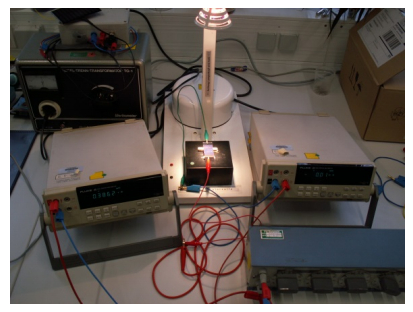
 DownLoad:
DownLoad: 